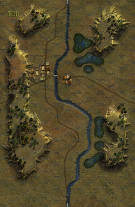| Author |
JayTownsend
|
| Method |
Solo |
| Victor |
Draw |
| Play Date |
2017-05-19 |
| Language |
English |
| Scenario |
KWCA045
|
Korean War: Counter-Attack, scenario #45: Crossing the Han
As you know, I love real amphibious landing scenarios and LVT-3 and LVT (A)-5 vehicle types. When I read about this engagement and even though it was on land, it was still crossing the Han River in amphibious vehicles, I knew it had to be a Panzer Grenadier scenarios, the cool factor alone would be worth it!
The North Korean setup splitting up their two forces on the two hill masses east of the river, dividing their mortar units as well, as they are the key to the Marines victory, knocking out both the 82mm and 120mm mortars, as they have been causing damage on the west side of the river. But splitting the mortar units the Americans will have to either risk going full force after one hill mass at a time with a short time factor or split their own forces and go after both units at the time but weakening their attacks.
The Marines choose to split their attacking force into two groups and attack both North Koreans forces at once. For once the NKPA ART unit has something to shoot at, with a weak armor, as the American LVT-3s and LVT (A)-5s only have an armor values of 0 and 1 and the ATR manages to take out two steps of the LVT-3s before finally be suppressed with off-board artillery fire. Some other tactical mistakes I made in my rush the beat the scenario time factor, was putting my Marine Infantry and HMG units adjacent to North Korean SMG & HMG units, losing two more steps. As sure the NKPA INF units only have a 4-2 bit but the SMG has a 6-1 and the HMG 7-4 so if you get a stack of these, they can hurt even the Marines and are better than the Japanese units from Saipan, so I have to change my thinking a bit in the future.
The NKPA only need to wait for the Marines to attack them and destroy three steps to win, which they did, four steps in fact but the marines were able to destroy both NKPA mortar units, largely with the help of the LVT A5 unit to make this scenario a Draw, as both sides won. Very tense with a 15 turn time limit and worth replaying again and again.
|



 KWCA044
KWCA044 






















Hi Jay !
Got some questions about the scenario. - Rivers are not shore lines! Do the LVT have to stop whenever entering a river hex? Do they have to stop whenever exiting a river hex? - What are the river crossing numbers needed for ? I suppose the LVT don't need these. Don't they ?
Hi Leonard. LVT don't use river crossing numbers. LVTs have an 8/3 movement, 8 being land movement points, 3 being water movement points. So if you started adjacent to a water depending on the terrain, you could move across the water hex for one movement in water costs MPs and still have 5 land movement points depending on the terrain, with the water movement taking 1/3 of the movement points from the land movement points if you only moved in one water hex that is.
I haven't thought about it too much, as I usually have LTVs in Ocean movement, which normally takes me all three water movements just to get to a beach and on the next turn usually 3 movement points for each beach hex and usually on the third turn I am out of there. Scenario 45 was a unique situation I read about in Marines History and said, I have to get that scenario into the mix. The Marines ended up using their LTVs especially their LTV (A)5s for fire support in a number of occasions.
Yes, the scenario situation is unusual and very interesting. I was just wondering about the rules... If the river was a shore line, the LVT would have to stop when entering water.
No, not if they have enough movement allowance left, they can keep going.